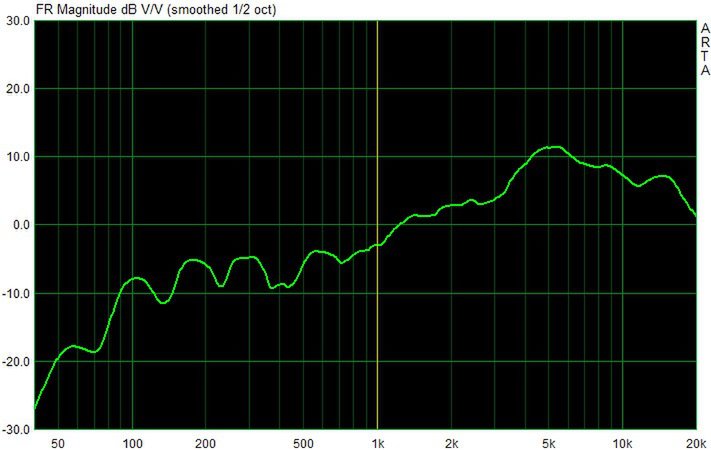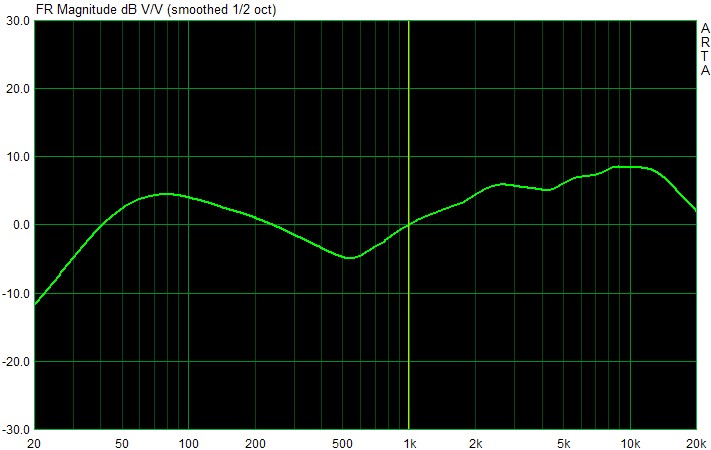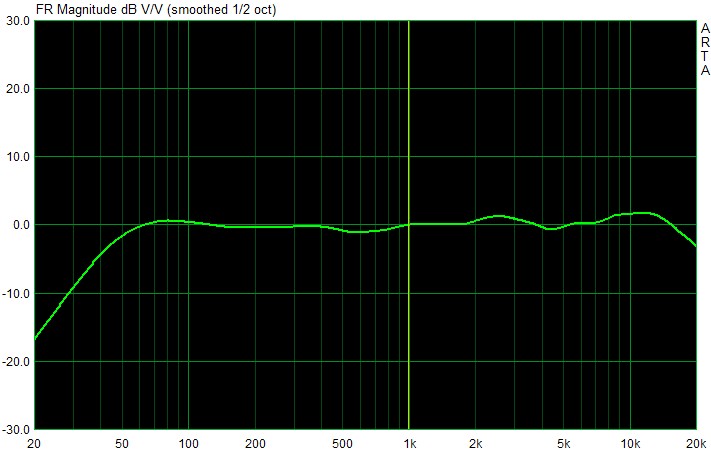Microphone measurement and sound check
First of all, we can also measure the frequency range of the microphone to accommodate the feedback of the readers. For this we use our measuring room again, but we virtually reverse the process. Of course, a true reciprocity calibration as a starting point exceeds our current possibilities and the effort far exceeds the benefits. That is why ir sought a compromise.
However, since we have a calibrated measuring microphone, a comparison measurement and the calculation of the differences can at least produce a curve that is easily usable for our purpose. So it is not the exact frequency response of the microphone, we would not presume that, but a meaningful approximation, which also underpins our subjective impression.

Measuring and audible, it can be seen that it is under approx. 100 Hz gives a low-cut, especially since the microphone is already not bass-heavy. A rumbling can thus be avoided quite well. The speech intelligibility is good to very good, but the level is not very high. Here you should make a slight level increase in the system settings (the sound card) if necessary. However, a slight noise should not be completely avoided.
What sounds a bit exaggerated are all Sibilants or Hissing, because the tweet is raised by almost 12 dB at five to six KHz. This almost provokes a metallic and cold sound, but does not affect the comprehensibility. Only blow-out and other wind noises are noticeable above average.
Headphone measurement
As we test, we have already explained in the basic article "Gaming Headsets: Myth, Truth and How we Test" very detailed and transparent, because with the usual audio-swirl of bass thunderstorms and high-pitched whips you can't really get any further. You have to be able to listen subjectively well and measure at the same time. Let us start with the latter.
If you look at the original curve, it doesn't look bad except for the usual bathtub delle and you ask yourself the legitimate question why it really had to be. Bass raises by approx. five dB and a high tone oversweetened with almost nine dB leave no doubt about having voted for this headset. But the Clearasil generation should not be underestimated either, because we are increasingly noting a strengthened sound consciousness, which of course makes us happy.

If you lift the neglected area at approx. 500 Hz by eight to nine dB, reduces the level at approx. 8 KHz by approx. five dB, as well as at two KHz by one to two dB, then you get between 45 Hz and approx. 16 KHz an almost linear course (+/- 3dB). We will see in a while that this sounds better (and also warmer) around worlds.

Subjective listening experience – Original against optimization
Bass
Test the lowest bass in the subcontraoctave (16.4 Hz to 32.7 Hz) with a recording of Bach's Toccata and Fugue in D minor (19 and 25 Hz) and the Festival Overture 1812 by Tchaikovsky (10 Hz and 12.5 Hz). The same applies to the lower ranges of the contraoctothe (32.7 to 65.4 Hz). The big bass drum (kick drum), which in the U-music is a welcome companion and usually on approx. 55 to 60 Hz, this assessment will then be rounded off.
The bass is already audibly more restrained from about 45 Hz downwards, but still has enough presence and even a quite passable resolution. With the new setting, everything looks a little more nuanced and clear, but without losing any pressure. From approx. 30 Hz it gets a bit thin down, but that doesn't really matter. The contraoctave is still completely present, which then calms the last deep-rider a little.
The large bass drum comes sufficiently crisp and the level strength is also right for this price range. The settling behavior is also fine and overall it can be said that the bass is not one of the dark sides of the Corsair universe.
The upper bass up to 150 Hz, in which also the Great Octave (65.4 to 130.8 Hz) is located, houses the basic language frequency of the male voice and decides very strongly on the true-to-life reproduction of male vocals.
This area already sounds reasonably balanced in the original and natural, albeit somewhat greased. The male vocals are (almost too) full and warm, the instruments are hardly distorted. Overall, the resolution is acceptable and does not allow sources that are too dominant to perform well and even locate them.
Frequency range
The lower middles (also basic tone range) are approx. 150 to 400 Hz. Together with the already mentioned upper bass, this area plays a very important role for the subjectively perceived heat or bass. Fullness of the sound. The basic language frequency of female voices can be found in this area.
Female vocals still get quite neat to the point. The timbre of the vocals and recorded instruments is rather warm in the original, in no case it is analytical. However, the further upward progression is already much better with the optimized profile, because you completely neutralize the starting bathtub. The manually created setting allows the tuning to slide further in the direction of warm and pleasant – actually a must for music lovers, although the pure gamer almost doesn't care.
The upper mids between 400 Hz and about two KHz contain a mark at a KHz, which is still considered a reference for many measurements. Unfortunately, this is often noticeable with cheaper devices, as manufacturers often try to overemphasize this frequency. This area does not play an insignificant role in gaming either, and balanced playback contributes significantly to good spatial resolution.
The drama and acoustic valley of the great tears is approx. 500 Hz. Without our tutoring on the equalizer, many instruments lack important nuances and the resolution also suffers enormously. Many details are blurred or go completely down screaming for help. The stage and the subjectively perceived quality of the spatial resolution are only at a fairly good level after our intervention.
For music lovers: An orchestra seems (purely subjectively) set up far enough, even if individual, rather quieter sources cannot always be located with real determination. Here you can still notice the price limits most likely. For gamers: the whole thing does not detract from the game, only a dignified pause would have to be dispensed with. But there is still our best friend, the equalizer. He then straightens up what the technicians in Asia have done on behalf of him.
High-pitched range
Between two and about 3.5 KHz, human hearing is most sensitive, especially since this area of the lower heights is responsible for the good overtone reproduction of the human voice. This frequency range is crucial for the recognition of a voice or instrument; in this context, one also speaks of the respective timbre.
The new profile is much more appropriate to the original timbre and everything sounds more natural around worlds, even if the original design is tolerable. Better is always possible and above all the location in the game is in both interpretations at any time at the level of the action. Sure, it would be (even) better, but there are significantly worse headsets. You have to be fair.
The middle heights (3.5 to six KHz) decide on the sound or failure of the speech reproduction as a whole, because the S- and hissing (Sibilants) fall into this range. The upper heights then reach up to approx. ten KHz to move into the super high tone.
High and super high tone have been raised far too much to really please in the original. It drifts here clearly into the metallic and tip, which leads to over-emphasis sibilants and blow-out noises. With the changed profile, however, the headset gains overall heat and also resolution.
The specified frequency curve from 20 Hz to 20 KHz, on the other hand, is pure utopia and, moreover, without specifying any tolerance limits, is in any case only silly PR waste. However, with the optimized settings on the EQ, we would be able to 45 Hz to 16 KHz with +/-3dB deviation, depending on the ear pad adjustment for the hearing. This is good and entirely appropriate to the price.
Summary and conclusion
The 60 Euro street price is an announcement to the competitors, no question. Nevertheless, it is things like the completely exaggerated bathtub and the somewhat too tight seat, which, while slavishly serving smaller Asian heads, already causes some discomfort to the rest of the world after wearing it for a long time. The HS50 doesn't really do anything wrong, which is why we let it go through as "tested". But it wasn't enough for the big show, albeit very narrowly.
If you as a gamer only doesn't attach great importance to true-to-original music reproduction, have a head under hat size 62 and want to hear more loud than neutral, you will surely find your affordable gold piece in the HS50. Linear fanatics with oversized heads and eyeglass wearers, on the other hand, should better look at the Creative SoundblasterX H5, which sits much more airy and hardly costs any more. But if you stand on bathtub, the big foam is wholeheartedly indulged. Then he can't do anything wrong with the HS50.
































Kommentieren